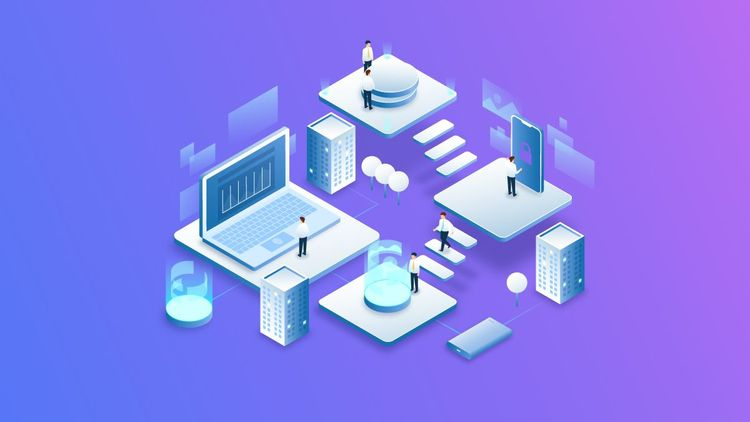Digital transformation is no longer a nice-to-have; it has now become inevitable and necessary for strategic business growth and operational excellence. It is, in short, a critical priority. Digital transformation is truly a catalyst for organization-wide efficiency. It has been equipping businesses with the necessary digital foundation and business practices. The far-reaching benefits the digital transformation effort has brought have accelerated over the last decade, and this paradigm shift is here to grow steadier at a large scale. No industry is immune to this global disruption.
But the path isn’t easy. When companies aim to fundamentally change the way they are operating and introduce something that can modernize legacy offerings, it takes a complete reinvention. In the process of digitizing services and processes, chances are that new risks could be introduced. Underdeveloped changes or minimal controls can jeopardize the plans.
Choosing the right technology is only part of the challenge. Transforming the core business, building new digital propositions, redesigning operations, integrating advanced analytics, setting up digital architectures, unifying the data, and refactoring the backend systems are all highly risky and demand incredible amounts of effort to strengthen and streamline.
Now hyperautomation is the missing piece in the puzzle. Hyperautomation complements the digital transformation efforts by involving a combination of tools— Business Process Management , Robotic Process Automation, Advanced Analytics, Process Mining, Machine Learning, and Intelligent Document Processing—that are leveraged to apply automation across business processes. Hyperautomation, in effect, presents a holistic approach to automation.
Why is digital transformation incomplete without hyperautomation?
Digital transformation, for all its advantages, can seem a daunting task to accomplish because of outdated systems that inhibit a full-scale implementation. These legacy systems demand a complete overhaul of organizational structure, leading to sunk costs, complexities, and inefficiencies. But when you involve Hyperautomation, businesses don’t need to throw out their ecosystems. The point of Hyperautomation is to optimize, streamline and enhance the processes by embedding intelligence-driven automation.
Typical digital transformation strategies involve digital technologies to extend capabilities. On the downside, enterprises get caught in an endless loop of simply doing digital projects, but still largely focusing on automating a few processes here and there. Though simple digital initiatives give the illusion of automation, the heart of the problem still remains unresolved. That is, the fragmentation of processes. When organizations aim for a business-wide transformation, disparate parts of the company fail to work together. These limitations can derail effective digital transformation efforts.
Hyperautomation addresses this operational divide. It rewrites the DNA of an organization by transforming processes into interconnected nodes. Whereas traditional automation creates solutions designed to automate individual tasks, Hyperautomation bridges the divide by building a more synchronized and less siloed infrastructure. It can be accomplished by a set of technology stack Hyperautomation brings together: low-code, BPM, robotic process automation (RPA), Doc AI, and Analytics.
Why hyperautomation platform matters: truly data-driven
Data is a valuable asset worth investing in. With more advanced disruptions to current operating and customer models, organizations that harness data-driven insights will be well-positioned to lead. Data will optimize nearly every aspect of future work.
But data becomes meaningless if a business doesn’t have a reliable system and platform to turn it into actionable insights. Hyperautomation unifies the disjointed data sources to refine them. The result is spectacular: a pattern emerges to inject insights into organizational processes. In every interaction and decision, data is deeply embedded. Unlike the ineffective, aimless digital transformation efforts that seem to be satisfied with simple, task-based automation, Hyperautomation fosters a data-driven culture to create truly differentiated automation.
Intelligent Document Processing (IDP), for example, effectively extracts structured and unstructured data to create seamless dataflow and import them into the system. In this process, IDP is complemented by Machine Learning as it increases the accuracy of data extraction. This way, various intelligent technologies come together to enhance a process and deliver accurate information faster. In this data-first business landscape, actionable intelligence will remain a strategic importance and Hyperautomation is at the forefront to deliver it.
Citizen developers in a digital ecosystem
Once full synchronization is successfully in place, now the question is how to strategize deployments that allow faster and more efficient changes to the environment. Customers today look for services that align with their preferences and values.
Low-code, a big boom for a decade now, has created citizen developers who can help adapt, improve, and innovate their business processes on their own. It allows companies to handle business challenges and find solutions faster and more confidently across all lines of business. Low-code’s easy-to-use visual and intuitive tools dramatically reduce the time it takes to build an app and enables businesses to meet the needs of customer personalization at scale.
BPM & RPA: key tools that offer robust Hyperautomation solutions
Vuram combines its Business Process Management offering along with its low-code, AI, and analytics solutions, making the Hyperautomation roadmap stronger and driving businesses toward experiencing process-based solutions.
From robust business process modeling and project management to building an agile architecture and timely project delivery, Hyperautomation’s involvement in BPM has been redefining the way organizations automate their processes. The results? Simplified processes, better operational visibility, and systematically improved efficiency.
Enterprise-level digital transformation efforts will be half-done until RPA comes into the picture. When Robotic Process Automation (RPA) comes in to automate rules-based tasks, it can be of huge help in automating tasks involving repetitiveness, high volume, and human errors associated with manual handling.
Vuram leverages RPA to automate the processing of Dark Data and integrate Google and Amazon’s Chatbots (Lex) while bringing in cognitive RPA to automate information-intensive processes.
Disruptions in global businesses demand the ability to quickly reconfigure operations to stay competitive. Even the best technological innovation will prove ineffective if organizations lack the right processes and strategies to unite them in a coherent way.
Hyperautomation’s use cases extend beyond a few processes, industries, or geographies. Hyperautomation is the foundation on which many emerging business operations are currently being built. The result helps companies accelerate delivery, manage risk proactively, and maximize ROI. Vuram’s role in helping a multibillion-dollar conglomerate in the Middle East with automating invoice processing and billing is a good example of Hyperautomation in action.
How Hyperautomation solutions identify the right process to automate: some industry use cases
Hyperautomation is not bound by limitations in terms of industries or specific processes. Whatever that can be automated, will be automated. In that line, we can see how Vuram applies Hyperautomation in two of the most process-intensive industries: banks and healthcare.
How does Hyperautomation reinvent a bank’s digital transformation efforts? When banks try to collect the personal information of their customers, most of them are willing to do that as long as the data is used by the banks to offer tailored solutions. But banks usually can’t deliver on this hyper-personalization. In the current business landscape, it takes a host of new technologies—all interacting with clean data and systems.
Now Hyperautomation brings intelligent technologies into a structured sequence of steps to help organizations go from simple digitization of manual paperwork to fully automated processes. Explosive data volumes are an important force driving the need for business-wide transformation.
Hyperautomation delivers significant cost savings to any bank willing to embrace it by deploying AI-based loan origination models and optimizing operations with intelligent processes. From loan processing to KYC, from delivering meaningful, data-driven insights on anti-money laundering (AML) to robust operational support for audit management, Hyperautomation helps banks gain real-time value and visibility into financial and operational data.
Considering the recent exponential advances in medical science, responding to the health crisis and accelerating the delivery of care may seem an impossible equation. Hyperautomation in healthcare involves rapidly evolving digital health technologies, care delivery models, and clinical innovation.
Hyperautomation is the right catalyst for an operational transformation. AI and ML components build accurate models to deliver optimized patient flow management, risk analysis and stratification, signs monitoring, predictive analytics, and automated alerts. These predictive models promise more connected care across channels, delivering more care to more patients, on a more personal level.
Vuram’s role in your Hyperautomation journey
Vuram, a global hyperautomation services company, has been delivering Hyperautomation services for more than a decade now. The company has been taking on the monumental task of building overarching strategies and a Hyperautomation roadmap for global businesses. They leverage key Hyperautomation tools to optimize enterprises’ core business operations. Their services come packed with BPM, ML, AI, and Analytics tools to identify inefficiencies and apply intelligent automation.
Armed with low-code, Vuram helps businesses break free from the monolithic development model and democratize the development of business automation through low-code. Business users, since they know better than anyone their workflows and processes, are well-equipped to build unique applications to solve problems. In the end, the company’s integrated tooling spins up specific business automation and is instrumental in driving digital transformation initiatives forward.












